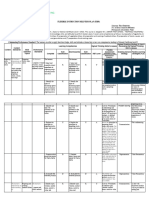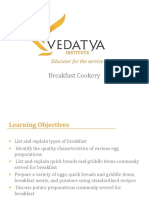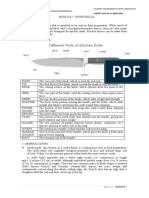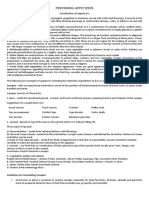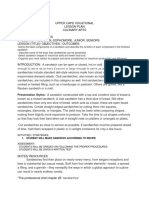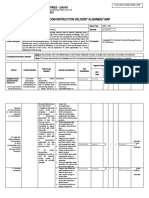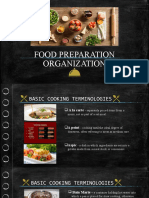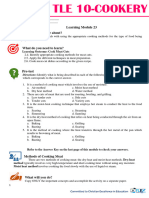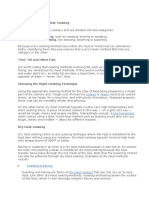Culinary Terms: Food Selection and Preparation
Uploaded by
Camille MalvecinoCulinary Terms: Food Selection and Preparation
Uploaded by
Camille Malvecino39 Page
Culinary Terms
A La Carte: Menu in which items and beverages are priced
individually
A la grecque: A preparation style where vegetables are marinated in
olive oil, lemon juice, and herbs and served cold.
A Point: French term for cooking until the ideal degree of doneness.
When referred to meat, it means medium rare.
Additives: Substances added to many foods to prevent spoilage or
to improve appearance, texture, flavor or nutrition. They might be
synthetic materials copied from nature or naturally occurring
substances.
Airline Breast: Boneless chicken breast with the first wing bone still
attached.
Ballontine: Boneless poultry leg stuffed with forcemeat and gently
roasted/braised, traditionally shaped into a ball.
Base: A substance the neutralizes an acid in a liquid solution.
Al Dente: Italian term meaning “to the tooth”. Used to describe mainly
pasta that is cooked until a slight resistance when bitten into.
Allemande: Sauce made by adding lemon juice and liaison to veloute
made from veal stock.
Food Selection and Preparation
40 Page
Allumette: A matchstick cut 3 mm x 3mm x 5 to 6 cm (1/8 in x 1/8 in
x 2 to 2-1/2 in) long and usually for potatoes.
Bain Marie: Hot water bath used to gently cook food or keep food
hot. Container for holding food in a hot water bath.
Basic Sauces: Also known as leading or mother sauces, the
foundation for the entire classic repertoire of hot sauces. The five
leading sauces (Bechamel, veloute, espagnole, tomato, and
hollandaise)
Baste: To moisten foods using their natural juices periodically during
cooking.
Bechamel: A basic sauce made by thickening milk with a white roux
and adding seasonings.
Bisque: A pureed soup made from crustacean shells, classic
versions are thickened with rice.
Bloom: A white powdery layer that sometimes appears on chocolate
if the cocoa butter separates.
Bound Salad: A salad comprising of cooked meats, poultry, fish,
shellfish, pasta or potatoes combined with a dressing.
Blanching: To briefly submerge in simmering water, boiling water, or
fat to assist in the preparation of foods. Example: Tomato concassee
Bouquet Garni: Fresh herbs and vegetables tied into a cheesecloth
bundle and used to flavor sauces, soups, stocks, stews.
Brine: A mixture of salt, water, and seasoning used to preserve
foods.
Brochette: Skewered hors d’oeuvres using meats, fish, shellfish,
vegetables and grilled or broiled.
Canape: A tiny open-faced sandwich served as an hors d’ouevre.
Capon: Class of surgically castrated male chickens.
Food Selection and Preparation
41 Page
Chiffonade: A preparation of finely sliced or shredded leafy
vegetables or herbs.
Coagulation: The irreversible transformation of proteins from a liquid
or semi-liquid state to a drier, solid state.
Canape: A tiny open-faced sandwich served as an hors d’ouevre.
Capon: Class of surgically castrated male chickens.
Chiffonade: A preparation of finely sliced or shredded leafy
vegetables or herbs.
Coagulation: The irreversible transformation of proteins from a liquid
or semi-liquid state to a drier, solid state.
Concasse: Peeled, seeded and diced tomato
Court bouillon: Water simmered with vegetables, seasonings and
an acidic product such as vinegar or wine. Used for simmering or
poaching fish, shellfish or vegetables.
Croquette: A food that has been pureed or bound with a thick sauce.
Deglaze: To swirl or stir in a liquid into a hot pan to lift away
caramelized food particles
Degrease: To remove fat from the surface of a liquid such as a stock
or sauce by skimming the surface.
Dredging: To coat a food item in flour or ground crumbs prior to
frying or sauteing.
Egg Wash: A mixture of beaten eggs (whole eggs, yolks or whites)
and a liquid, usually water or milk, used to coat dough before baking.
Emulsion: A uniform mixture of two unmixable liquids, such as oil
and water, are forced into a uniform distribution.
Essence: A sauce made from a concentrated vegetable juice.
Fillet: Removing the side of fish intact while removing all bones.
Flambe: Food flamed by use of alcohol for flavor.
Food Selection and Preparation
42 Page
Flash Frozen: Food that has been frozen very rapidly using metal
plates, extremely low temperatures or chemical solutions.
Flavonoids: Plant pigments that dissolve readily in water, found in
red, purple and white vegetables such as blueberries, red cabbage,
and beats.
Foie Gras: Liver os specially fattened geese or ducks.
Fond: French for stock or base. Drippings and bits of food left in a
pan after foods are roasted.
Fondant: Sweet, thick opaque sugar paste used for glazing pastries
such as napoleons or making candies.
Frenching: Trimming racks of rib or poultry so the bone is cleaned
and prominent.
Jacquard: The process of poking holes into the muscle of meat in
order to tenderize.
Mince: To cut into very small pieces where uniformity or shape is not
important.
Mise en Place: Meaning “Everything in place”, refers to the
preparation and organization of ingredients and equipment
Professional Cooking: System of cooking that appreciates the
proper techniques of ingredients and knowledge.
Render: To transform solid fat into liquid form by use of heat.
Refreshing: Submerging a hot food item in cold water to quickly stop
the cooking process. Also known as an ice bath.
Nappe: A certain consistency in a liquid that coats the back of a
spoon.
Needling: Injecting fat or flavors into an ingredient to enhance
moisture or flavor.
Parboiling: To partial cook a food in simmering/boiling water. Similar
to blanching, but cooked for longer.
Food Selection and Preparation
43 Page
Parcooking: Partially cooking food by any cooking method.
Paupiette: Thin slice of meat, poultry or fish spread with savory
stuffing and rolled and braised or poached.
Rondeau: Shallow, wide, straight-sided pot with loop handles.
Roulade: Slice of meat, poultry or fish rolled around a stuffing.
Sachet: Containing herbs and spices used to flavor stocks, soups,
and sauces. Easily removable.
Sauteuse: Basic sauteing pan with sloped sides and single long
handle.
Sautoir: A variation of a saute pan with straight sides and long
handle.
Savory: Spied or seasoned foods, as opposed to sweet.
Scald: To heat a liquid, usually milk to just below boiling.
Sear: Brown food quickly over high heat, done as a preparatory step
for further methods such as braising or roasting.
Silverskin: Tough connective tissue that surrounds certain muscles.
Staling: Known as starch retrogradation, change in moisture within
starch that causes products to turn firm, drier and more crumbly.
Steep: Soaking food in a hot liquid in order to extract flavor or remove
impurities.
Sweat: To cook food in a pan, usually covered, without browning over
low heat to encourage flavors to be extracted from vegetables and
spices.
Tempering: To slowly add hot liquid to eggs while stirring vigorously
to slowly bring the mixture up to temperature without curdling the
eggs.
Tourner: To shape vegetables while peeling. The procedure is to
peel, then shape.
Food Selection and Preparation
44 Page
Kitchen Aids
Kitchen aids –are home appliances that makes your food
preparation much more easier. Simplify our time in kitchen.
DIFFERENT TYPES OF KITCHEN AIDS
1. Kitchen aid blender
Make use of a speed control that will allow the
blade to crush ice, pure soft fruits and vegetables and
blend extra thick desserts.
The blades are specifically designed to maximize
chopping while at the same time liquifying ingredients
as quickly as possible.
2. Kitchen aid food processor
Use to shred and juliene your favorite fruits,
vegeables and hard cheeses and also allows you to
slice from thick to thin with one slide of the lever.
This accomodates various size of food or less
preparation work.
3. Hand blender
Referred to as a stick or hand blender, this
design is always handled. These blenders are
extremely versatile and convenient for blending and
mixing foods.
Food Selection and Preparation
45 Page
4. Kettle
Type of pot, specialized for boiling water with
a lid, spout and handle. Kettles can be heated
either by placing on stove or bt their own internal
electric heating element in the appliance version.
5. Sparkling beverage maker
Allows you to make refreshing home made
carbonated drinks.
6. Cook processor
A small countertop appliance with a dozen
capabilities including boiling, frying, steaming,
stewing, kneading, chopping, mincing,
pureeing, mixing, emulsifying, whipping and
stirring.
Food Selection and Preparation
46 Page
Cooking Methods
Grill
When grilling food, the heat source
comes from the bottom. Think cooking a
steak on a grill — the heat only comes
from the coals underneath the grate.
Grilling usually involves an open flame, but
can also be done with a grill pan on a
stovetop. Foods are cooked by heating the
grill grates, which gives ingredients the charred, grilled lines.
Pan-frying
Pan-frying is done by adding
enough fat to a hot pan so that the fat
comes up about half an inch up the side
of the pan. Food is partially submerged in
the fat and then flipped over so the other
side can cook. An example is a crabcake,
which is cooked until golden brown on
one side and then turned over so the other side can brown.
Deep-frying
Deep-frying is when food is completely
submerged in a hot fat. The result is a
crispy, golden brown exterior and a fully
cooked interior.
Food Selection and Preparation
47 Page
Saute
Sautéed foods are cooked in a thin
layer of fat over medium-high heat, usually
in a frying pan on the stovetop. Foods are
just cooked until tender.
Boil
Typically, foods are boiled in water,
which reaches a boil at 212 degrees
Fahrenheit. Foods are completely
submerged in the boiling liquid and cooked
until tender, then drained.
Roast
Roasting is generally the same as
baking, but refers more to proteins and
vegetables. Roasting is common to do
in the oven and items are coo ked until
golden brown and tender. The most
common item that's roasted is a turkey
on Thanksgiving.
Bake
Baking is similar to roasting, but
refers more to breads, pastries, and other
sweet item s. Most items are baked in the
oven until cooked through.
Sear
Searing is done with minimal amounts
of fat over high heat. Searing foods gives
them a brown, caramelized outside, while not
cooking the interior fully. Think searing a thin
piece of fish so that is has crispy skin and a
Food Selection and Preparation
48 Page
delicate, tender inside.
Poach
To poac h food, it should be
completely submerged in liquid that is
between 160 and 180 degrees. The food
item remains in the liquid until fully cooked
through and tender.
Simmer
When simmering food, it is usually
cooked with a liquid in a pot on the
stovetop. It is done over low heat and tiny
bubbles should appear on the surface.
Broil
Broiling is similar to grilling, except
the heat source comes from the top. It is
usually done in an oven by adjusting the
setting to broil. Broiling happens very
quickly and it’s best to watch the food
carefully when broiling so it does not burn.
Getting the cheese on top of lasagna
golden brown and crispy is an example of broiling.
Steam
To cook an ingredient with steam,
food is usually placed in a separate
steamer over hot liquid. The food is cooked
by the steam from the liquid and does not
come in contact with the liquid.
Food Selection and Preparation
49 Page
Blanch
Blanching is similar to boiling, except
the food is par-cooked and then
submerged immediately in an ice-bath to
stop the cooking process.
Braise
Braising is a combination cooking
method that first involves sautéing or
searing an item, then simmering it in
liquid for a long cooking period until
tender. Foods that are braised are often
larger proteins like pot roasts and
poultry legs.
Stew
Stewing is similar to braising
because the ingredient is first seared
and then cooked in liquid, but it uses
smaller ingredients like diced meats and
vegetables.
Food Selection and Preparation
You might also like
- 101 Things I Learned in Culinary School by Louis EguarasNo ratings yet101 Things I Learned in Culinary School by Louis Eguaras122 pages
- Importance of Organizing and Preparing Food - Group 1 CookeryNo ratings yetImportance of Organizing and Preparing Food - Group 1 Cookery7 pages
- Cooking Meals and Dishes According To Recipe: 3 Types of Basic Cooking TechniquesNo ratings yetCooking Meals and Dishes According To Recipe: 3 Types of Basic Cooking Techniques30 pages
- Soups - Introduction and ClassificationNo ratings yetSoups - Introduction and Classification17 pages
- Learning Activity Sheets Tvl-He-Cookery-Grade 12: Embutido100% (1)Learning Activity Sheets Tvl-He-Cookery-Grade 12: Embutido4 pages
- Basic Cooking: Preparation and Cooking FoodNo ratings yetBasic Cooking: Preparation and Cooking Food6 pages
- Module 2 Prepare Stocks Soups and SaucesNo ratings yetModule 2 Prepare Stocks Soups and Sauces21 pages
- Learning Module in Cookery 12: Lesson 1: Learning Outcomes: - Performance: StandardNo ratings yetLearning Module in Cookery 12: Lesson 1: Learning Outcomes: - Performance: Standard4 pages
- Food Preparation: Begin: Soups, Stocks, and SaucesNo ratings yetFood Preparation: Begin: Soups, Stocks, and Sauces42 pages
- Stock, Sauces, And, Soups - For Cookery 10No ratings yetStock, Sauces, And, Soups - For Cookery 108 pages
- Multiple Choice: Test:Topic 6 Cooking PoultryNo ratings yetMultiple Choice: Test:Topic 6 Cooking Poultry5 pages
- Housekeeping: Why Should We Pay Attention To Housekeeping at Work?No ratings yetHousekeeping: Why Should We Pay Attention To Housekeeping at Work?11 pages
- Housekeeping: Why Should We Pay Attention To Housekeeping at Work?No ratings yetHousekeeping: Why Should We Pay Attention To Housekeeping at Work?11 pages
- Dry Heat and Moist Heat Cooking: Brisket ShankNo ratings yetDry Heat and Moist Heat Cooking: Brisket Shank10 pages
- Culinary Terms: Food Selection and PreparationNo ratings yetCulinary Terms: Food Selection and Preparation11 pages
- Effect of Heat To Meat and Dry Heat CookingNo ratings yetEffect of Heat To Meat and Dry Heat Cooking1 page
- Instant download 爱的终结 消极关系的社会学 转换版 法 伊娃 易洛思 pdf all chapter100% (1)Instant download 爱的终结 消极关系的社会学 转换版 法 伊娃 易洛思 pdf all chapter34 pages
- Pan-Seared Strip Steaks - America's Test KitchenNo ratings yetPan-Seared Strip Steaks - America's Test Kitchen2 pages
- (FREE PDF Sample) Norm and Ideology in Spoken French: A Sociolinguistic History of Liaison 1st Edition David Hornsby Ebooks100% (2)(FREE PDF Sample) Norm and Ideology in Spoken French: A Sociolinguistic History of Liaison 1st Edition David Hornsby Ebooks49 pages
- 101 Things I Learned in Culinary School by Louis Eguaras101 Things I Learned in Culinary School by Louis Eguaras
- Importance of Organizing and Preparing Food - Group 1 CookeryImportance of Organizing and Preparing Food - Group 1 Cookery
- Cooking Meals and Dishes According To Recipe: 3 Types of Basic Cooking TechniquesCooking Meals and Dishes According To Recipe: 3 Types of Basic Cooking Techniques
- Learning Activity Sheets Tvl-He-Cookery-Grade 12: EmbutidoLearning Activity Sheets Tvl-He-Cookery-Grade 12: Embutido
- Learning Module in Cookery 12: Lesson 1: Learning Outcomes: - Performance: StandardLearning Module in Cookery 12: Lesson 1: Learning Outcomes: - Performance: Standard
- Food Preparation: Begin: Soups, Stocks, and SaucesFood Preparation: Begin: Soups, Stocks, and Sauces
- Housekeeping: Why Should We Pay Attention To Housekeeping at Work?Housekeeping: Why Should We Pay Attention To Housekeeping at Work?
- Housekeeping: Why Should We Pay Attention To Housekeeping at Work?Housekeeping: Why Should We Pay Attention To Housekeeping at Work?
- Instant download 爱的终结 消极关系的社会学 转换版 法 伊娃 易洛思 pdf all chapterInstant download 爱的终结 消极关系的社会学 转换版 法 伊娃 易洛思 pdf all chapter
- (FREE PDF Sample) Norm and Ideology in Spoken French: A Sociolinguistic History of Liaison 1st Edition David Hornsby Ebooks(FREE PDF Sample) Norm and Ideology in Spoken French: A Sociolinguistic History of Liaison 1st Edition David Hornsby Ebooks

